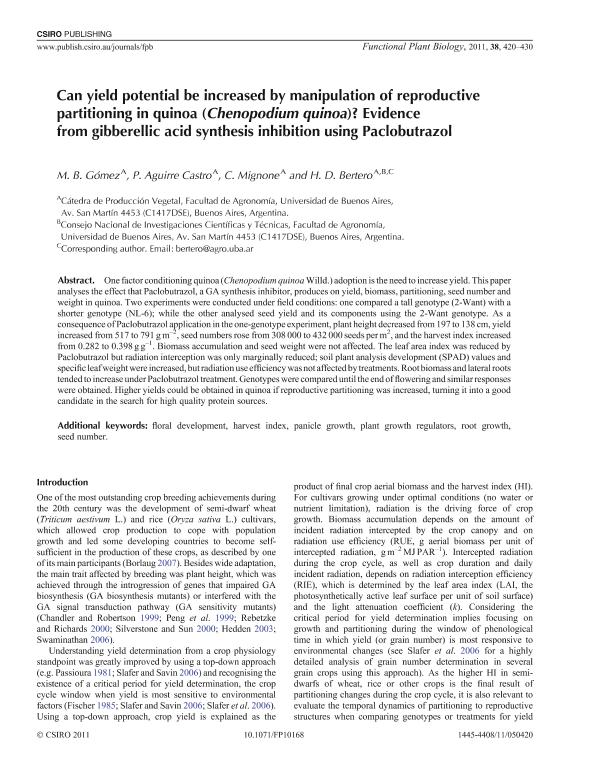Artículo
Can yield potential be increased by manipulation of reproductive partitioning in quinoa (Chenopodium quinoa)? Evidence from Gibberellic Acid synthesis inhibition using Paclobutrazol
Fecha de publicación:
05/2011
Editorial:
Csiro Publishing
Revista:
Functional Plant Biology
ISSN:
1445-4408
Idioma:
Inglés
Tipo de recurso:
Artículo publicado
Clasificación temática:
Resumen
One factor conditioning quinoa (Chenopodium quinoa Willd.) adoption is the need to increase yield. This paper analyses the effect that Paclobutrazol, a GA synthesis inhibitor, produces on yield, biomass, partitioning, seed number and weight in quinoa. Two experiments were conducted under field conditions: one compared a tall genotype (2-Want) with a shorter genotype (NL-6); while the other analysed seed yield and its components using the 2-Want genotype. As a consequence of Paclobutrazol application in the one-genotype experiment, plant height decreased from 197 to 138 cm, yield increased from 517 to 791 g m–2, seed numbers rose from 308 000 to 432 000 seeds per m2, and the harvest index increased from 0.282 to 0.398 g g–1. Biomass accumulation and seed weight were not affected. The leaf area index was reduced by Paclobutrazol but radiation interception was only marginally reduced; soil plant analysis development (SPAD) values and specific leaf weight were increased, but radiation use efficiency was not affected by treatments. Root biomass and lateral roots tended to increase under Paclobutrazol treatment. Genotypes were compared until the end of flowering and similar responses were obtained. Higher yields could be obtained in quinoa if reproductive partitioning was increased, turning it into a good candidate in the search for high quality protein sources.
Palabras clave:
Yield Potential
,
Gibberellic Acid
,
Paclobutrazol
,
Reproductive Partitioning
Archivos asociados
Licencia
Identificadores
Colecciones
Articulos(OCA PQUE. CENTENARIO)
Articulos de OFICINA DE COORDINACION ADMINISTRATIVA PQUE. CENTENARIO
Articulos de OFICINA DE COORDINACION ADMINISTRATIVA PQUE. CENTENARIO
Citación
Gómez, María Belén; Aguirre Castro, P.; Mignone, C.; Bertero, Hector Daniel; Can yield potential be increased by manipulation of reproductive partitioning in quinoa (Chenopodium quinoa)? Evidence from Gibberellic Acid synthesis inhibition using Paclobutrazol; Csiro Publishing; Functional Plant Biology; 38; 5; 5-2011; 420-430
Compartir
Altmétricas




